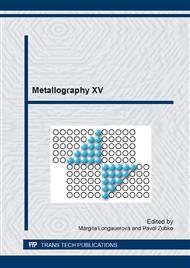p.137
p.143
p.149
p.155
p.161
p.166
p.172
p.179
p.186
Microstructural Stability of Long-Term Annealed AZ91 Magnesium Alloy Weld Joint
Abstract:
Welding and pad welding are widely used methods of repair and regeneration of defective magnesium alloys castings. AZ91 is one of the most popular magnesium alloys used at temperature up to 120°C. Therefore there is need to study the influence of welding and elevated temperature exposure on the microstructure and properties of AZ91 weld joints. This paper discusses microstructural stability of AZ91 gas tungsten arc weld joint in T6 condition (solution treated and aged). In order to examine the weld joints microstructural stability, the long-term annealing has been carried out at 120°C. Hardness of the base metal and fusion weld was measured after 250, 500, 750 and 1000h exposure respectively. Additionally, the base metals and the welds microstructure after 1000h annealing was investigated. Both in the base metal and in the weld, long-term annealing caused decrease in the intermetallic phases volume fraction. However, neither phase composition nor hardness of the weld joint were influenced by the heat treatment. Based on these results, it could be stated that the microstructure of investigated weld joint is stable at working temperature.
Info:
Periodical:
Pages:
161-165
Citation:
Online since:
April 2014
Authors:
Keywords:
Price:
Сopyright:
© 2014 Trans Tech Publications Ltd. All Rights Reserved
Share:
Citation:


